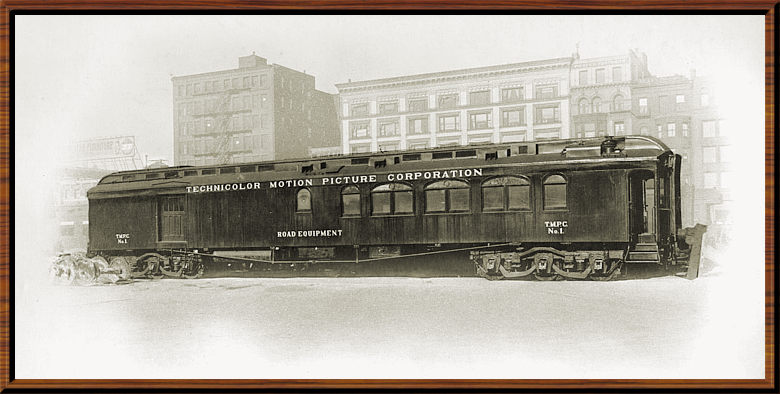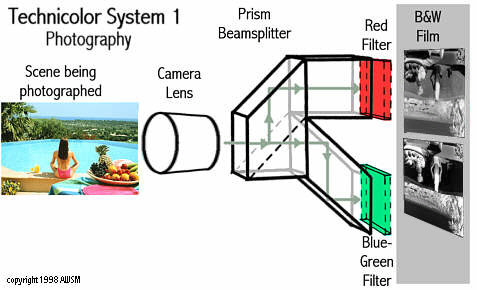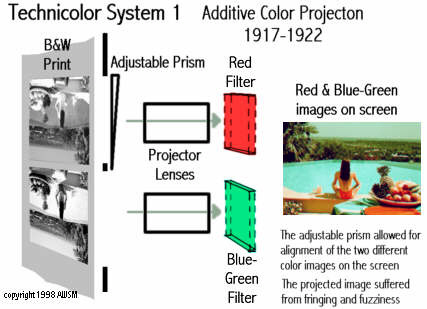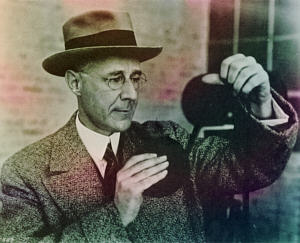Technicolor History 1 (original) (raw)
The history of the Technicolor Corporation is probably one of the most fascinating in the motion picture or any other industry. It was not originally my intention to provide such a history here, but it is nearly impossible to discuss the technical aspects without following the chain of events that drove the development of the cinema's most illustrious photographic process. Additional details of the company, its technology, and Technicolor films may be found in these two highly recommended books:
TECHNICOLOR MOVIES - The History of Dye Transfer Printing, by Richard W. Haines, published by McFarland & Company, Inc., Publishers. ISBN 0-89950-856-1
GLORIOUS TECHNICOLOR - The Movies' Magic Rainbow, by Fred E. Basten, published privately by the author and Technicolor, Inc.
Both books may be found on Amazon.com.
In addition to my own narrative on the history and technology of Technicolor, wonderful as it is, the reader will find several article reprints, dating from 1935, 1938, and 1942. These are published versions of presentations made by J.A. Ball, Herbert Kalmus and Winton Hoch, ASC to the Society of Motion Picture Engineers. Links to these articles are located in the navigation area at the bottom of each page of this section.
Additionally, I have prepared a virtual copy of a 1934 article from Fortune magazine that provides an exhaustive report on the people, technology, and financial aspects of Technicolor, Inc. written just after the completion of the first live action short subject, La Cucaracha. Excellent full color illustrations! Another example of the great effort and expense that your curator has gone to in order to bring you the history of film technology.
The History and Technology of T E C H N I C O L O R

Pardon me boys, is that the Technicolor Choo Choo?
Photo courtesy John Hiller, Smithsonian Institution,
National Museum of American History, Photographic History Collection.
In 1912 the firm of Kalmus, Comstock, and Wescott was formed by Herbert Kalmus & Daniel Comstock, graduates from M.I.T. and W. Burton Wescott, a man described as a mechanical genius despite his not holding a college degree. The firm achieved some financial success following work in the abrasives industry.
Kalmus developed an interest in creating a viable natural color motion picture process after taking on a commission to produce a "flicker-free" movie system, and Technicolor Corporation was founded in 1915. The "Tech" in Technicolor was derived from their association with the Massachusetts Institute of Technology. And the name had a nice ring to it.
Technicolor System 1 - Additive Color 1917-1922
The company's first color process was a two color additive system similar to Kinemacolor but with two major differences. The Technicolor camera recorded the red and blue-green images simultaneously through a single lens using a beam splitter and color filters to record the images stacked one on top of the other. No rotating color wheel was involved in either the camera or projector. The print was a conventional black and white record that ran through a special projector with two apertures and lenses with color filters adding the tint.
Technicolor camera #1, the only one built and used for photography in system 1. The camera is in the collection of the Smithsonian Institution, National Museum of American History, Photographic History Collection, and is officially classified as a national treasure of The United States of America. We Yanks don't have crown jewels and such.
Photo courtesy of John Hiller - The Smithsonian
Illustrations based on sketches in Technicolor Movies by Richard W. Haines.While this scheme had the ability to present pleasant colors onscreen, it suffered from the need for a special projector and the premiere of Technicolor's first film, The Gulf Between (1917), proved a disappointment when the theatre projectionist apparently found it difficult to adjust the projector prism to properly register the two color images on screen.
>
> A frame blowup from The Gulf Between, the first two color Technicolor production, photographed in Florida in 1917. Technicolor used a railroad car for a portable lab which allowed the Boston based company to shoot on location and develop and print the product on the spot. The photo of the railroad car seen above was once the property of Dr. Comstock.
Even as the company attempted to exploit this system, they were busy developing a new technique that would overcome the shortcomings and variables inherent in the first design.
---
The King and Queen of Technicolor
Herbert and Natalie Kalmus
If you think Charles and Diana had problems.... No piece written about Natalie Kalmus has ever been found that didn't include the word "bitch". The Curator sees no need for name calling, especially when others have done it so eloquently.
---
**** 2 Color Subtractive Systems**
2 Color Subtractive Systems**
You are on page 1 of the Technicolor History
You may jump to any other page










---
#####
©1999-2003 The American WideScreen Museum Photographic and printing process illustrations ©1999-2003 AWSM - All Rights Reserved


